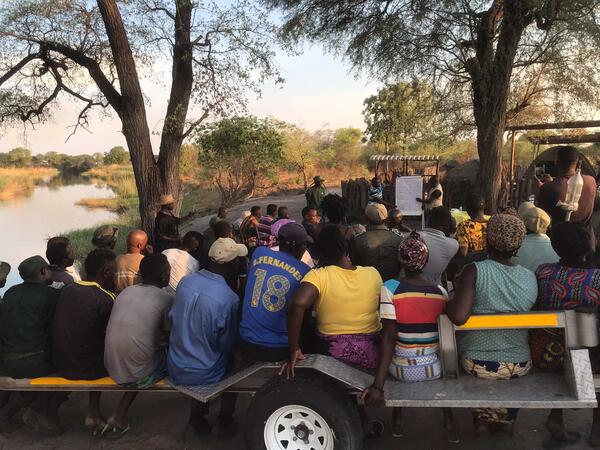
Over five years ago, NACSO’s Natural Resources Working Group and WWF Namibia collaborated with officials from ACADIR (The Association for the Conservation of the Environment and Integrated Rural Development) and the Angolan Ministry of Environment to establish annual game counts in the newly (at the time) proclaimed Luengue-Luiana National Park, located in the Cuando Cubango province in the south-eastern corner of Angola. Namibia was able to render their support to Angola for two reasons: 1) NACSO, WWF Namibia, and the Ministry of Environment, Forestry and Tourism have over 20 years’ experience conducting annual game counts in communal conservancies and in state protected areas, and 2) Angola is an integral part of KAZA, more specifically the Luengue-Luiana National Park lies within this important Transfrontier Conservation Area and is neighboured to the south by Bwabwata National Park in Namibia and to the east by Sioma-Ngwezi National Park in Zambia. It is therefore imperative that the wildlife in this park which is part of the TFCA landscape is systematically monitored.
The support provided at that time included essential materials for the survey, personnel to provide training, GIS and mapping services as well as the compilation and analysis of data to provide survey results for adaptive management purposes. Funding for the entire activity has since been provided annually through different stakeholders. Due to the international travel restrictions consequent to the Covid-19 pandemic, the Namibian team has been unable to physically participate in the counts. This year, the team was invited to participate in this important annual activity once again. The invitation was also extended to Namibian participants through the IRDNC’s KAZA component manager, Mr John Kamwi, who coordinates CBO activities in relation to transboundary forums. Accordingly, John also ensured that participants from Botswana and Zambia were present to take part in the count. More than 40 participants from the local communities in Cuando-Cubango, ACADIR, Angolan Ministry of Environment, NACSO, IRDNC, WWF Zambia, communal conservancies, associations and transboundary forums were present for the 7-day activity.
It was a very early morning drive which began at 04h30 am from Rundu with the team from ACADIR leading the way. The thick, sandy, winding road eventually led us to Jamba, ten hours later. After all the tents were set up, we sat down to discuss the upcoming activity, exchange ideas and suggestions. For logistical reasons, it was agreed to host the training and count at Benorio, a base camp on the banks of the Kwando River just 70 km southeast of Jamba, which is in closer proximity to the settlements found within the park. We set out for Benorio the next morning and waited for the arrival of the remaining participants. We had a full in-depth training the next day to ensure that the game count methodologies were well understood and to explain the concept of systematic wildlife monitoring. As is custom to the game count training, the larger group was divided up into five smaller teams, one allocated to each of the five routes. Drivers familiar with the routes were specifically chosen to make sure that the routes were well followed. On the 21st of October at exactly 05:00, all the teams were ready at the start of their routes. In total, 16 different species were seen during the counts, this includes elephant, buffalo, leopard, sable, lechwe, reedbuck, and bat-eared fox.
The results were received with excitement, with this sample count being a possible indicator that there could be more wildlife in the area. Wildlife number predictions in the area can be made as soon as the data is analysed and compared to the trends of the last years of count data. The feedback ended in a discussion of what the results meant for the park and the future cooperation in KAZA. Suggestions included adding further routes as well as walking transects and excitingly, maybe even a riverboat count on the Kwando River which makes up the eastern border of the park. There was also a consensus from the group to challenge ourselves to learn each other’s languages to improve communication and limit challenges caused by language barriers. Along with the laughter, joy and camaraderie experienced after conducting a successful game count, the parting message was to strengthen relationships within KAZA and to streamline activities such as game counts to happen around the same time for better monitoring results.





